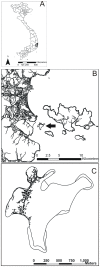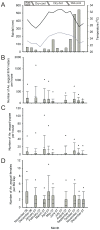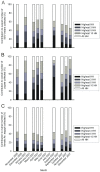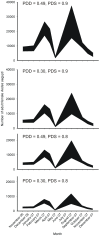Characterizing the Aedes aegypti population in a Vietnamese village in preparation for a Wolbachia-based mosquito control strategy to eliminate dengue
- PMID: 19956588
- PMCID: PMC2780318
- DOI: 10.1371/journal.pntd.0000552
Characterizing the Aedes aegypti population in a Vietnamese village in preparation for a Wolbachia-based mosquito control strategy to eliminate dengue
Abstract
Background: A life-shortening strain of the obligate intracellular bacteria Wolbachia, called wMelPop, is seen as a promising new tool for the control of Aedes aegypti. However, developing a vector control strategy based on the release of mosquitoes transinfected with wMelPop requires detailed knowledge of the demographics of the target population.
Methodology/principal findings: In Tri Nguyen village (611 households) on Hon Mieu Island in central Vietnam, we conducted nine quantitative entomologic surveys over 14 months to determine if Ae. aegypti populations were spatially and temporally homogenous, and to estimate population size. There was no obvious relationship between mosquito (larval, pupal or adult) abundance and temperature and rainfall, and no area of the village supported consistently high numbers of mosquitoes. In almost all surveys, key premises produced high numbers of Ae. aegypti. However, these premises were not consistent between surveys. For an intervention based on a single release of wMelPop-infected Ae. aegypti, release ratios of infected to uninfected adult mosquitoes of all age classes are estimated to be 1.8-6.7ratio1 for gravid females (and similarly aged males) or teneral adults, respectively. We calculated that adult female mosquito abundance in Tri Nguyen village could range from 1.1 to 43.3 individuals of all age classes per house. Thus, an intervention could require the release of 2-78 wMelPop-infected gravid females and similarly aged males per house, or 7-290 infected teneral female and male mosquitoes per house.
Conclusions/significance: Given the variability we encountered, this study highlights the importance of multiple entomologic surveys when evaluating the spatial structure of a vector population or estimating population size. If a single release of wMelPop-infected Ae. aegypti were to occur when wild Ae. aegypti abundance was at its maximum, a preintervention control program would be necessary to ensure that there was no net increase in mosquito numbers. However, because of the short-term temporal heterogeneity, the inconsistent spatial structure and the impact of transient key premises that we observed, the feasibility of multiple releases of smaller numbers of mosquitoes also needs to be considered. In either case, fewer wMelPop-infected mosquitoes would then need to be released, which will likely be more acceptable to householders.
Conflict of interest statement
The authors have declared that no competing interests exist.
Figures






Similar articles
-
Adult survivorship of the dengue mosquito Aedes aegypti varies seasonally in central Vietnam.PLoS Negl Trop Dis. 2014 Feb 13;8(2):e2669. doi: 10.1371/journal.pntd.0002669. eCollection 2014 Feb. PLoS Negl Trop Dis. 2014. PMID: 24551251 Free PMC article.
-
Field evaluation of the establishment potential of wMelPop Wolbachia in Australia and Vietnam for dengue control.Parasit Vectors. 2015 Oct 28;8:563. doi: 10.1186/s13071-015-1174-x. Parasit Vectors. 2015. PMID: 26510523 Free PMC article.
-
Assessing quality of life-shortening Wolbachia-infected Aedes aegypti mosquitoes in the field based on capture rates and morphometric assessments.Parasit Vectors. 2014 Feb 3;7:58. doi: 10.1186/1756-3305-7-58. Parasit Vectors. 2014. PMID: 24495395 Free PMC article.
-
Can Wolbachia be used to control malaria?Mem Inst Oswaldo Cruz. 2011 Aug;106 Suppl 1:212-7. doi: 10.1590/s0074-02762011000900026. Mem Inst Oswaldo Cruz. 2011. PMID: 21881776 Review.
-
Wolbachia-based emerging strategies for control of vector-transmitted disease.Acta Trop. 2024 Dec;260:107410. doi: 10.1016/j.actatropica.2024.107410. Epub 2024 Sep 28. Acta Trop. 2024. PMID: 39349234 Free PMC article. Review.
Cited by
-
Adult survivorship of the dengue mosquito Aedes aegypti varies seasonally in central Vietnam.PLoS Negl Trop Dis. 2014 Feb 13;8(2):e2669. doi: 10.1371/journal.pntd.0002669. eCollection 2014 Feb. PLoS Negl Trop Dis. 2014. PMID: 24551251 Free PMC article.
-
Prevention and Control Strategies to Counter Dengue Virus Infection.Front Cell Infect Microbiol. 2017 Jul 25;7:336. doi: 10.3389/fcimb.2017.00336. eCollection 2017. Front Cell Infect Microbiol. 2017. PMID: 28791258 Free PMC article. Review.
-
Enhancement of the BG-sentinel trap with varying number of mice for field sampling of male and female Aedes albopictus mosquitoes.Parasit Vectors. 2016 Sep 22;9(1):514. doi: 10.1186/s13071-016-1801-1. Parasit Vectors. 2016. PMID: 27658455 Free PMC article.
-
Field- and clinically derived estimates of Wolbachia-mediated blocking of dengue virus transmission potential in Aedes aegypti mosquitoes.Proc Natl Acad Sci U S A. 2018 Jan 9;115(2):361-366. doi: 10.1073/pnas.1715788115. Epub 2017 Dec 26. Proc Natl Acad Sci U S A. 2018. PMID: 29279375 Free PMC article.
-
Infertility and fecundity loss of Wolbachia-infected Aedes aegypti hatched from quiescent eggs is expected to alter invasion dynamics.PLoS Negl Trop Dis. 2021 Feb 16;15(2):e0009179. doi: 10.1371/journal.pntd.0009179. eCollection 2021 Feb. PLoS Negl Trop Dis. 2021. PMID: 33591971 Free PMC article.
References
-
- Gubler DJ. Dengue and dengue hemorrhagic fever: its history and resurgence as a global public health problem. In: Gubler DJ, Kuno G, editors. Dengue and dengue hemorrhagic fever. New York: CAB International; 1997. pp. 1–22.
-
- Rodhain F, Rosen L. Mosquito vectors and dengue virus-vector relationships. In: Gubler DJ, Kuno G, editors. Dengue and Dengue Hemorrhagic Fever. New York: CAB International; 1997. pp. 45–60.
-
- Gubler DJ. The global emergence/resurgence of arboviral diseases as public health problems. Arch Med Res. 2002;33:330–342. - PubMed
-
- Townson H. Wolbachia as a potential tool for suppressing filarial transmission. Ann Trop Med Parasitol. 2002;96(Suppl 2):S117–127. - PubMed
-
- Turelli M, Hoffmann AA. Rapid spread of an inherited incompatibility factor in California Drosophila. Nature. 1991;353:440–442. - PubMed
Publication types
MeSH terms
LinkOut - more resources
Full Text Sources
Medical

